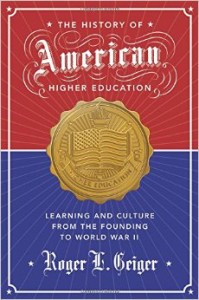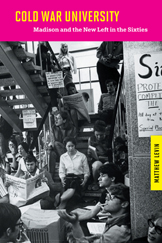Review Essay by Brian M. Ingrassia, West Texas A&M University
Matthew Levin. Cold War University: Madison and the New Left in the Sixties. Madison: University of Wisconsin Press, 2013.
Roger L. Geiger. The History of American Higher Education: Learning and Culture from the Founding to World War II. Princeton, NJ: Princeton University Press, 2014.
The early twenty-first century is a critical time for American higher education. In Wisconsin, Governor Scott Walker is trying to weaken tenure. In North Carolina, the state legislature is attempting to mandate 4-4 course loads for all public university faculty. In Illinois, administrators are under investigation after effectively firing a new faculty member because of his supposed “incivility” while advancing a politically controversial position via social media. Everywhere, campuses engage in a virtual arms race, seeking donors and pouring millions into facilities to attract the largest incoming classes. Administrators proliferate while the work of teaching is increasingly placed on the shoulders of overworked and undercompensated contingent faculty—including a growing army of just-in-time adjuncts. Meanwhile, the public gets its academic bread and circus by consuming a big-time athletic spectacle that enriches coaches and athletic departments while exploiting student labor.
This is a tremendous time, in other words, to revisit the history of American higher education. More than half a century after scholarship on academic life flowered in the wake of the 1950s McCarthy-era Red Scare, scholars and lay readers alike are primed for incisive scholarship that places higher education in its social, cultural, political, and intellectual contexts.
Roger L. Geiger has authored The History of American Higher Education: Learning and Culture from the Founding to World War II, a masterwork that will be a standard reference for students of American history. Geiger shows how “institutions that began in an isolated, provincial colonial society evolved into a system that served an incipient economic powerhouse by 1940.” After the 1860s, America’s universities increasingly served “an industrializing economy, an urbanizing society, and a global knowledge regime” (ix). The basic framework of this story is a familiar one, but Geiger has made a contribution by thoroughly mining of a generation of scholarship on higher education. He ably tells the  story of America’s colleges and universities from the founding of Harvard College in the seventeenth century to the standardization of American higher education in the twentieth. While some may miss the storyteller prose of classics like Frederick Rudolph’s The American College and University: A History (1962), all readers should appreciate the rigor of Geiger’s lengthy yet eminently readable book. Even seasoned veterans of this subfield will learn from this exhaustive and illuminating volume.
story of America’s colleges and universities from the founding of Harvard College in the seventeenth century to the standardization of American higher education in the twentieth. While some may miss the storyteller prose of classics like Frederick Rudolph’s The American College and University: A History (1962), all readers should appreciate the rigor of Geiger’s lengthy yet eminently readable book. Even seasoned veterans of this subfield will learn from this exhaustive and illuminating volume.
Intellectual history is a part of Geiger’s story, but it is not the main focus. The author is mainly concerned with administrators and institution building; intellectual currents are primarily a backdrop for tales of institutional origins and curricular debates. New England’s earliest colleges were founded as bulwarks of Puritan orthodoxy. By the mid-1700s, though, Enlightenment influences inspired curricular innovations such as the teaching of Newtonian physics and the use of “philosophical apparatus” in scientific pedagogy (49). John Witherspoon brought Common Sense philosophy to American higher education when he left Scotland to become Princeton’s president in 1768. Sixty years later, Jeremiah Day and the Yale faculty authored the famous reports that defended classical education and provided intellectual justification for rejecting practical curricula. Nevertheless, in the 1850s Francis Wayland tried to introduce practical studies at Brown University, a transformation that only really took off with the rise of the land grant college movement during and after the Civil War. Although Harvard dispatched the first Americans to study at Göttingen before 1820, the impact of German scholarship became truly apparent in the latter decades of the nineteenth century, when hundreds of Americans returned from their transatlantic sojourns “with a dedication to pure science and…the German style of research” (329). This scholarly influx provided the basis for the research universities nurtured in the early 1900s. By the Great Depression, Marxism became popular among students and campus YMCA chapters were infused with Social Gospel ideals.
Geiger does not focus as much on the “extracurriculum”—student activities and culture, including sports—as some previous historians of higher education. However, he does a particularly good job of outlining how universities like Harvard and Penn appropriated and strengthened professional education starting in the 1800s; the ways that institutions like Cornell and Johns Hopkins pioneered graduate education after the Civil War; and the role of funding agencies like the Carnegie Corporation and the Rockefeller Foundation in promoting research in the early 1900s. The Gilded Age’s captains of industry, Geiger shows, played a major role in transforming America’s erudition factories.
While Geiger focuses on pre-World War II institution building, Matthew Levin’s Cold War University gives us a taste of how the magnificently constructed edifice became unsettled after 1945. A case study of the University of Wisconsin at Madison (UW), Levin’s book shows how mid-twentieth-century sites of knowledge production experienced a “deepening relationship between the federal government and the university” during the Cold War. This was an era that saw “the phenomenal growth of scientific research on university campuses, a shift in higher education toward technical training, and a massive increase in enrollments, all within the context of a rapidly developing relationship between  the federal government and the academic world” (16). The U.S. Army, the Office of Naval Research, NASA, and Dow (manufacturer of napalm) were just a few of the agencies and corporations fueling UW’s 1950s growth.
the federal government and the academic world” (16). The U.S. Army, the Office of Naval Research, NASA, and Dow (manufacturer of napalm) were just a few of the agencies and corporations fueling UW’s 1950s growth.
Fractures in the Cold War-era campus consensus developed in the 1960s, though, when students began rejecting the military-industrial-educational complex. A week-long anti-Vietnam War “draft sit-in” in May 1966 borrowed its methods and terminology from civil rights activists. Spearheaded by a group called the Committee on the University and the Draft, the demonstration brought attention to “the connection between…the university’s tacit support for the draft and support for American foreign policy in Vietnam” (5). Students gained little support from a divided faculty, yet they pushed on, forming the Wisconsin Draft Resistance Union. The next year hundreds of antiwar students violently protested Dow’s campus presence by blocking access to a building where the company was interviewing prospective employees. As one activist scathingly wrote, UW was “furnishing the technicians who create the tools of destruction as well as the facilities for hiring these technicians” (151). Student unrest was not limited to antiwar protests. In spring 1969 students’ Black Power demands—a Black Studies department and the admission of African American students who had been expelled from UW’s Oshkosh campus—resulted in the so-called “Black Strike.” Once again, students and police clashed. By far the most violent and notorious episode, though, was the bombing of Sterling Hall, home of the Army Mathematics Research Center, on the morning of August 24, 1970. Over twenty buildings were damaged and a postdoctoral student in physics (ironically, one of the more antiwar departments on campus) was killed. This was a time, following the shootings at Kent State and Jackson State, when “violence seemed routine to some in the New Left” (176).
Intellectual historians will appreciate the great detail with which Levin tells the story of Madison’s New Left efflorescence. After setting the stage by discussing Wisconsin’s history of progressive politics and education, Cold War University shows how Madison saw a post-1945 influx of students from New York, some of whom were steeped in radical leftist traditions. These East Coast transplants, alongside homegrown Wisconsin radicals, joined the many student activist groups, including the Labor Youth League and the Committee to End the War in Vietnam. Levin illustrates how faculty members—including socialist historian William Appleman Williams, author of the seminal The Tragedy of American Diplomacy (1959)—influenced UW students. Indeed, readers of Cold War University may recognize a few names from their own bookshelves. For instance, Joan Wallach Scott admired the activists’ passion (133), while Marty Sklar, a critic of the Old Left, edited Studies on the Left, the “most concrete product of the political and intellectual environment” of early-1960s Madison (88).
By the end of this enlightening book one is left to wonder if Madison was exceptional or representative. To what extent is this story similar to events that may have unfolded in Urbana, Minneapolis, or Bloomington—or, for that matter, Chapel Hill or Austin? Intellectual historians would no doubt welcome additional studies illuminating the transformation of Cold War universities into a different type of institution by the 1970s.
Such studies are particularly important insofar as one can easily imagine how the tale of Madison in 1966 or 1967 helps us understand Madison in 2015. As the New Left flourished on campus, notes Levin, conservatives at the other end of State Street condemned the activists. Surely, by the 1980s—a time when federal funding declined precipitously from the heady days of the Cold War and the Great Society—legislators must have continued seeking ways to limit campus radicalism. This story of backlash and postindustrial neoliberalism—as much as the pre-1940 growth and consolidation of American higher education—needs to be told. One can only hope that Geiger is hard at work on the sequel to his History of American Higher Education, one that will incorporate the findings of monographs such as Levin’s book.

One Thought on this Post
S-USIH Comment Policy
We ask that those who participate in the discussions generated in the Comments section do so with the same decorum as they would in any other academic setting or context. Since the USIH bloggers write under our real names, we would prefer that our commenters also identify themselves by their real name. As our primary goal is to stimulate and engage in fruitful and productive discussion, ad hominem attacks (personal or professional), unnecessary insults, and/or mean-spiritedness have no place in the USIH Blog’s Comments section. Therefore, we reserve the right to remove any comments that contain any of the above and/or are not intended to further the discussion of the topic of the post. We welcome suggestions for corrections to any of our posts. As the official blog of the Society of US Intellectual History, we hope to foster a diverse community of scholars and readers who engage with one another in discussions of US intellectual history, broadly understood.
Thanks, Brian, for this excellent review. It appears that Roger Geiger’s book must be added to my shelves, if not Levin’s too. What justification does Geiger provide for stopping at World War II? Space? Lack of an argument? Too much source material? – TL